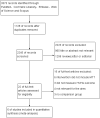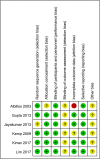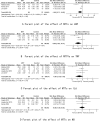Antibiotics and probiotics on hepatic venous pressure gradient in cirrhosis: A systematic review and a meta-analysis
- PMID: 36040984
- PMCID: PMC9426916
- DOI: 10.1371/journal.pone.0273231
Antibiotics and probiotics on hepatic venous pressure gradient in cirrhosis: A systematic review and a meta-analysis
Abstract
Background: Modulation of the gut microbiome could favorably alter the hepatic venous pressure gradient (HVPG) in cirrhosis and portal hypertension (PH).
Aim: This meta-analysis was to evaluate the effects of microbiome-targeted therapies (MTTs) on HVPG in persons with cirrhosis and PH.
Methods: PubMed, The Cochrane Library, Embase, Web of Science and Scopus were searched for randomized clinical trials (RCTs) analyzing the effects on HVPG in people with cirrhosis who received MTTs. Clinical outcomes were pooled using RevMan5.3 software. A trial sequential analysis was applied to calculate the required information size and evaluate the credibility of the meta-analysis results.
Results: A total of six studies were included. MTTs were associated with a reduction of 1.22 mm Hg in HVPG (95% CI: -2.31, -0.14 mmHg, P = 0.03). Subgroup analysis showed a greater reduction with longer duration (-1.88 mmHg;95% CI: -3.23, -0.53; P = 0.006). In the trial sequential analysis of HVPG reduction, the cumulative Z curve crossed the traditional significance boundary without the achievement of required information size (330).
Conclusions: MTTs may be associated with a reduction in HVPG in patients with cirrhosis and PH. Microbiome-targeted therapies merit additional large-sample studies to define the efficacy of HVPG.
Systematic review registration: PROSPERO 2020: CRD4202021609.
Conflict of interest statement
The authors have declared that no competing interests exist.
Figures







Similar articles
-
Etiology Control for Reducing Hepatic Vein Pressure Gradient in Patients With Cirrhosis and Portal Hypertension: A Systematic Review and Meta-Analysis.J Dig Dis. 2025 Jan-Feb;26(1-2):31-43. doi: 10.1111/1751-2980.13343. Epub 2025 Apr 10. J Dig Dis. 2025. PMID: 40210234
-
Effect of poorly absorbable antibiotics on hepatic venous pressure gradient in cirrhosis: A systematic review and meta-analysis.Dig Liver Dis. 2020 Sep;52(9):958-965. doi: 10.1016/j.dld.2020.06.048. Epub 2020 Jul 28. Dig Liver Dis. 2020. PMID: 32736898
-
[Analysis of 833 times measured hepatic venous pressure gradient].Zhonghua Gan Zang Bing Za Zhi. 2018 Apr 20;26(4):266-270. doi: 10.3760/cma.j.issn.1007-3418.2018.04.007. Zhonghua Gan Zang Bing Za Zhi. 2018. PMID: 29996337 Chinese.
-
Effects of the adjunctive probiotic VSL#3 on portal haemodynamics in patients with cirrhosis and large varices: a randomized trial.Liver Int. 2013 Sep;33(8):1148-57. doi: 10.1111/liv.12172. Epub 2013 Apr 21. Liver Int. 2013. PMID: 23601333 Clinical Trial.
-
Effect of viral suppression on hepatic venous pressure gradient in hepatitis C with cirrhosis and portal hypertension.J Viral Hepat. 2017 Oct;24(10):823-831. doi: 10.1111/jvh.12706. Epub 2017 Apr 10. J Viral Hepat. 2017. PMID: 28295923
Cited by
-
Antibiotics in Chronic Liver Disease and Their Effects on Gut Microbiota.Antibiotics (Basel). 2023 Sep 22;12(10):1475. doi: 10.3390/antibiotics12101475. Antibiotics (Basel). 2023. PMID: 37887176 Free PMC article. Review.
References
-
- Kerbert AJ, Chiang FW, van der Werf M, Stijnen T, Slingerland H, et al.. Hemodynamic response to primary prophylactic therapy with nonselective beta-blockers is related to a reduction of first variceal bleeding risk in liver cirrhosis: a meta-analysis. Eur J Gastroenterol Hepatol 2017; 29:380–387. - PubMed
Publication types
MeSH terms
Substances
LinkOut - more resources
Full Text Sources

